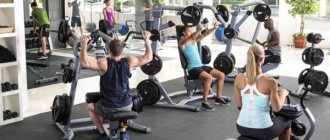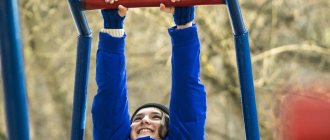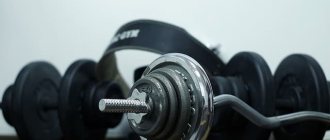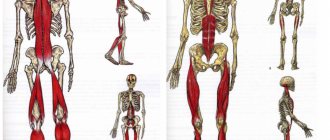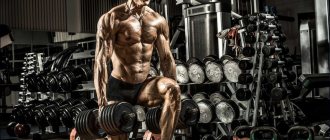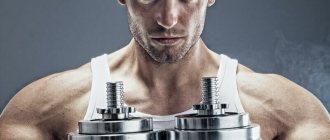Introduction (cry of the soul)
First of all, ardent supporters of running, I want to draw your attention to the fact that the topic concerns specifically running and bodybuilding (and other strength training), I personally have nothing against running itself...
Running is a great form of aerobic activity, and I'm generally for any physical activity.
This is always better than nothing, than the complete absence of anything (inaction).
But, be that as it may, specifically running and bodybuilding (namely, gaining muscle mass) are not compatible if the goal is maximum muscle growth. And now I will explain to you why I think so.
Running and bodybuilding are compatible (only if the goal is burning excess fat, but not gaining mass).
By the way, these are short answers for those who don’t like to read)).
Lunges with dumbbells overhead
What is involved: quadriceps, hamstrings, buttocks, shoulders, core muscles
Hold a pair of dumbbells directly above your shoulders without bending your arms, and keep your elbows tight. Lunge forward with your left leg, lowering your body so that your knee is bent 90 degrees. Then return to the starting position and repeat the same for the right leg. This counts as one repetition. Perform 6-8 repetitions on each leg.
Variation : To make it easier, hold the dumbbells at shoulder level.
Running trains the heart
Very often, supporters of running are foaming at the mouth to prove that running is very good for the heart.
Once, I had a very epic dialogue with one person regarding this issue, somehow the dialogue began to spin, in general, when I said that I had been doing bodybuilding for many years, he, for reasons unknown to me)) out of the blue, asked: “Do you run?”, I said no, and then the fun began)))
He asks: “How is this? Are you serious? If you don’t run?, that’s not right, you need to run a lot, running is very useful, all muscle groups are trained, and the most important thing is the heart, and in general the heart is the most important muscle.
Without a heart - all your muscles are in one place... then he began to prove, they say, look, you have increased in size (meaning you have gained muscles, your weight has increased), but your heart remained the same as it was, so the body may not cope with the load and make ends meet, do you need it? you need to run.."
Fortunately, in that discussion, I managed to convince my interlocutor)), now it’s your turn.
Indeed, while running, the heart has to contract much more often than at rest, and if you run regularly, your body will adapt to the load and become stronger and stronger (strengthen). This is really true!
However, for some reason (I don’t know), many people do not take into account the fact that regular training with iron (bodybuilding) trains our heart in the same way.
This is very easy to test/feel in your own skin while performing complex multi-joint exercises that involve a large number of muscles, for example, squats with a barbell or deadlift.
After you perform a heavy squat or deadlift, place your hand on your heart and you will understand what I am talking about... (you will hear a distinct beat in the chest area).
Moreover, training with iron trains our heart much more effectively than running.
Why? Yes, because regardless of the load, our heart always contracts with constant force. The only thing that changes is the frequency of contractions, and nothing more.
So what then is heart training, you ask? So the frequency of contractions is the training of the heart. Logical, right? Therefore, compare running and strength training (in the gym).
Can you guess where the frequency of contractions is greater? ... the conclusions are obvious.
Moreover, during your strength training (in the gym), the load on the heart is of an interval nature, because sets are successively replaced by rest, well, you know, once you do a set, you take a rest (1-2 minutes) and so on continuously throughout the entire workout.
This, in turn, is very good for the heart, unlike running to exhaustion.
However, in running it is also possible to control this process (however, this is very inconvenient and this is different from the complete rest that we do during the rest between heavy approaches), i.e. even if you don’t run constantly at one speed (for example, 12 km/h), but do it at intervals (2 minutes at 12 km/h, 2 minutes at 10, etc., then it’s all the same not like with iron).
In fact, running can actually be very beneficial for training your heart, however, only if you run with a heart rate monitor in the 110-130 beats per minute zone.
In fact, the point here is not even in the running itself, but in constantly keeping the heart rate in the desired zone for an hour (i.e. 110-130 beats per minute), but you must understand that instead of running it can be a bicycle, rollers .. or training with iron in the gym.. whatever, from the point of view of the heart - it doesn’t matter.
The main thing is to keep the heart rate at 110-130 beats per minute.
In general, many people who have experienced heart disease are aware that doctors, first of all, recommend losing excess weight, and not some kind of running.
After all, in the majority, it is excess fat in the form of excess (non-functional) weight that leads to heart disease.
But how you lose excess weight is a completely different matter, and most likely, running is the first thing that (on a subconscious level) comes to mind, because misinformation is everywhere, and you’ve probably heard the story that, they say, running is the most An effective tool to combat weight gain.
However, I assure you, this is not so, read the details below.
"Scorpion"
What is involved: abdominal muscles, hips, back
To begin, lie face down on the floor with your arms out to the sides (forming a T) with your thumbs pointing up. Press your chin toward the floor to avoid straining your neck. Bend your left knee and move your leg to the right, trying to reach your right shoulder with your toe. Hold this position for 30 seconds, then return to the starting position. Repeat for the other leg. Turning your right and left legs once counts as one repetition. Perform 3-5 repetitions.
Variations : To make it easier, touch your toe to the opposite buttock. As your flexibility and mobility increase, you will be able to reach your shoulder.
Running/Strength Training and Fat Burning
As I said above, you've probably heard that running is the most effective tool for losing weight.
So, this is another myth that has been and is being propagated so persistently by many magazines/personal trainers/media, etc.. well, actually because of this, most people listen to all this.
Any cardio activity (in our case, running) burns much fewer calories than is commonly thought... take my word for it, when running, of course, calories are burned)), but not as many as you naively believe.
Don't believe me? Ok, I'll prove it to you! => On my website in the menu there is a section “tables”, namely look for the sub-item “human energy consumption”. Go there (for the accuracy of the information that I will provide you below).
Have you moved on? OK. Look for physical activity in the “sports” category, namely “running,” most often people run at a speed of 10 kilometers per hour. What's next? Next, you remember the coefficient that is given next to physical activity (i.e. 0.1759).
Now, let’s get straight to the calculations: in order to find out your energy consumption, you need to multiply the coefficient by your weight and the duration of physical activity, in our case running 10 km/h, coefficient 0.1759.
Let's say you weigh 80 kilograms, you go for a 30 minute jog, in total you will spend:
0.1759 x 80 x 30 = 422.16 calories over this period of time.
Those. in half an hour of running = you will burn 422.16 calories.
Now, go to the calorie content of foods and see how many calories are in 200 grams of bread or a glass of milk or a 100g bar. chocolate... I assure you, the result will sadden everyone)).
Okay, what about strength training, you ask.
But with strength training, everything is completely different.
Any aerobics (i.e., in our case, running), as well as bodybuilding, stimulate metabolism for several hours after training.
However, due to the nature of running training, the fat burning process ends immediately after you put something in your mouth after your run.
Those. if you eat something after running, you will immediately stop the fat burning process due to the release of insulin by the pancreas, which blocks the utilization of fat at the root.
How often does this happen to people? The man got ready to go for a run, went, ran for a whole hour, eventually came and got drunk on something, borscht with a piece of bread with mayonnaise)) in the end, everything he did was useless)).
But in bodybuilding (strength training), the story (as I reported earlier) is completely different.
The fact is that strength training also stimulates the breakdown and restructuring of muscle cells, unlike aerobics (running). And where restructuring occurs, there is always an increased need for building materials and energy (i.e. food, carbohydrates + proteins), which is why after strength training, you can and even should eat, and this will not block fat utilization.
Because the body needs energy to build and repair damaged muscle tissue, as a result, strength training, on the one hand, can add muscle to your body, and on the other hand, it forces your body to burn calories in a much larger volume, and not only during training, but also after it, even when you are just sleeping and doing nothing. Do you understand this?
Do you see this difference between running and strength training (bodybuilding)?
Here, the conclusions are obvious: strength training is much more effective than any cardio (running)!
Conclusion: Once your workout is complete, anaerobic training (training with iron) will create a greater calorie deficit than aerobic training (running).
In other words, running will burn more calories during training than iron (barbells, dumbbells, etc.), but if we take it more broadly (i.e., consider not just one hour of the workout itself, but the whole day), then iron will burn more calories per counting the energy needed to restore our muscles.
Alternating bent over row
What works: mid back, biceps, core muscles
Take dumbbells and hold them at arm's length in front of you, with your palms facing your thighs. The back should be straight. Push your hips back and tilt your body so that your upper body is almost parallel to the floor. Don't bend your arms as you abduct your hips and make sure the dumbbells are parallel to the floor. Then perform a row with your left arm, bending it at the elbow and bringing it to the middle part of the back, parallel to the body. Lower your hand and repeat the same for your right hand. This counts as one repetition. Perform 10-12 repetitions.
Variations : To make it easier, perform the row with both arms at the same time (this type of strength exercise for runners requires less core stability)
translation
Aerobics (running) and muscle gain
There are opinions that running (somehow) helps the growth of muscle mass.
I don’t understand how this is possible, because, for those who don’t know: absolutely any strength load (so-called anaerobic training) causes our body to produce anabolic hormones, which subsequently trigger growth reactions.
But aerobic training (in our case, running), on the contrary, fights this phenomenon, triggering decay reactions (catabolism). Anabolism - growth | catabolism - destruction. Do you understand?
Why this happens cannot be explained in a few words, the topic is worthy of a separate issue, the main thing is that, firstly, this is really so, and secondly, understand the essence of what was said and you will literally “see the light”.
Conclusion: this is why I don’t understand how running can help grow muscle mass? And this is why I believe that if your goal is to gain muscle mass, you need to avoid any aerobic activity (in our case, running).
If the goal is to gain muscle mass (muscle) = no running!
Also, many people are trying to combine bodybuilding (gaining muscle mass) and running...
Say, Mon-Wed-Fri = strength training, and Tue-Thu-Sat = running... or in a similar style..
People naively believe that this will promote (accelerate, so to speak) the growth of muscle mass (muscle growth).
Or people naively want, they say, to gain muscle mass and lose weight = at the same time (thereby killing two birds with one stone). Alas, all these people have no idea what they are doing...
Firstly, if you exercise on days off from bodybuilding, then you will in no way accelerate the growth of your muscles (how do you even imagine that?...), on the contrary, you will only slow down your recovery process after training with iron, which will only lead to to a decline in training weights or even to overtraining.
In both cases, you will not achieve anything good; on the contrary, you will only harm yourself.
And secondly, as for gaining muscle + losing weight (burning fat) at the same time, this is basically impossible! Because anabolism (weight gain) = growth, and catabolism (weight loss) = destruction.
Weight is a calorie surplus, and weight loss is a calorie deficit))
It is simply impossible a priori to combine these two processes into one! Please understand this once and for all...
The same goes for those people who try to combine running before or after strength training.
In the first case (before training), with a long run, you will spend your energy reserves for a full workout, which will ultimately affect the strength training itself (you will not have the strength to train fully).
And in the second case (running after strength training), it won’t do anything good in terms of muscle growth, because in this way you will “lose weight,” yes, yes, in this case, you will not gain weight, on the contrary, you will only lose weight , and not only fat will “burn”, but also your muscles.
This happens due to the fact that in the first 20 minutes you use up glycogen, which is in the muscles, and in the next 20 minutes you use up glycogen from the liver, which is why everyone says (and rightly so) that you need to train for 40-45 minutes no more, but in our case, after 40-45 minutes of strength training, if we continue to train (or worse, run), then we will actively lose both fat and muscle!
General conclusion: If your goal is to gain muscle mass, then you need to avoid any aerobic activity (in our case, running)! Remember this once and for all, and do not listen to those who are trying to convince you of this.
Hyperextension
What works: lower back, glutes, mid back, shoulders
Lie face down on an exercise ball with your legs wide apart for balance. Bend your elbows slightly and touch the floor to initially support your body.
Squeeze your glutes and lift your upper body to form a straight line. As you lift your upper body, lift your arms off the floor while keeping your elbows bent. Place your hands behind your head. Stay in this position for 1-2 seconds . Lower your arms and lower your upper body back to the starting position. This is one repetition. Try to complete 10-12 repetitions. If you don't have a fitball, do the exercise on a special mat. Lift your hips and arms off the floor, keeping your upper body pressed to the floor.
Variations : To make it more challenging, pick up light dumbbells.
Bodybuilding (burning excess fat) + running
Please note that now we are talking about burning excess fat (the so-called cutting, among professionals) + running (cardio), i.e. We are no longer talking about gaining muscle mass, we are already talking about losing weight.
So, strength training with iron (anaerobic training) + running (aerobic exercise) at the stage of burning excess fat = guarantees the fastest possible result (in terms of weight loss).
Those. in other words, running (if your goal is fat burning) is good for you! Do you understand? If you are bulky, running is harmful, but if you are cutting (while losing weight), on the contrary, it can be beneficial. But there are also some nuances here, which I will tell you about now.
The fact is that to have a direct effect on fat, you need to walk quickly (not run) for a very long time (60 minutes or more). This is very important, pay attention to what I said - “walk quickly”, not run.
Why is this being done? To keep the intensity of aerobic exercise (running) low.
When the intensity is low, our body (organism) does not require a large amount of energy at once, therefore it is more profitable for the body to receive this energy from fat, which is important to us!
And if the intensity is high (fast running), then the body will need a lot of energy, which it will take not from fat, but from carbohydrates (as a result, we will burn a lot of both fat and muscle).
In fact, if you don’t care about your muscles, then run after training (as you wish, for a long time), but if you don’t care about your muscles, if you value them and want to burn mainly only fat (with a minimum of muscles ), you need to walk at a fast pace (not run) for a long time.
I keep saying about the duration of aerobic exercise (running/walking) that it should last for a long time.
How much exactly, you ask. The answer is simple: it should be long (60 minutes or more).
Why so long? Because such a duration of aerobic exercise is very economical in terms of energy supply, i.e. what interests us (fat) is wasted, but in small quantities...
And in order to increase these amounts, there is only one way out - to extend the time of spending along this path (i.e., extend the time of aerobic training (cardio) from 60 minutes or more!!! That’s actually the whole secret.
But! An important nuance: work according to how you feel. Breaking records from the very first training sessions is not worth it.
As they say, if you drive more quietly, you will continue. Valid in many areas. For example, can't do 60 minutes of cardio? Start with what you can! 15-20 minutes or 30, as long as you can and gradually up to an hour or more!
In general, the recommendation is this: listen to yourself, act gradually, according to how you feel.
It is very important. Especially for me to warn you about this. Health comes first.
Squats with Overhead Press
What works: glutes, hamstrings, lower back, upper back, shoulders
Grasp the kettlebell with both hands and hold it at chest level. Place your feet hip-width apart. Push your hips back and squat until your thighs are parallel to the floor. Perform a kettlebell overhead press. As you raise your body, return the kettlebell to the starting position. Perform 10-12 reps.
Variations : Perform the squat without raising your arms above your head, just hold the kettlebell at chest level throughout the exercise.
Ok, I understand how to combine strength training with running to burn fat?
Do aerobic training (cardio, brisk walking) when your body (organism) has a minimum amount of energy (carbohydrates), this will force your body to switch to burning fat as quickly as possible!
When does such a time come?
- In the morning on an empty stomach (because after a long sleep (usually it lasts 8-10 hours) there are no carbohydrates in your body, you didn’t get them from anywhere, you were sleeping).
- After strength training (because your muscles have already burned carbohydrate reserves during strength training, now you can safely switch to aerobics (i.e. running) in order to actively burn fat).
- Before going to bed (but there is one caveat here, the fact is that on a diet, as a rule, evening meals consist of protein, and as a rule, there are no carbohydrates, if in your case this is really the case, then this period of time, so It’s also effective, because you again have a lack of carbohydrates in your body (organism) (that’s why you ate proteins, not carbohydrates)).
Which of the above methods is the best? When is the best time?
Each method is good and has both its pros and cons.
However, I believe that the most efficient scheme would look like this:
- Do cardio in the morning on an empty stomach (brisk walking, 60 minutes or more)
- After training, do cardio (fast walking, from 60 min +)
Now I will tell you in detail how to properly conduct aerobic training during these periods of time, so that you have an idea of what to do.
Cardio in the morning on an empty stomach
We woke up and there was nothing to eat! This is especially true for carbohydrates, no carbohydrates, because if you sin, then these same carbohydrates will block your fat burning, and everything will be in vain (your entire run, to one place)!
You can drink water (plain without sugar). Then gradually get ready for cardio training.
How to do cardio? At a low pace (what I said was low-intensity training), this is either fast walking or slow running.
Your goal is the duration of the workout (it should be at least 60 minutes at a low pace).
Capsules or powder = essentially no difference
During this cardio (it is possible and even necessary, but not necessary, to take BCAA (amino acids) which consist of three essential amino acids (leucine, isoleucine, valine) that will protect your muscles from destruction), this way you will maintain your muscle mass, and at the same time burn fat.
After a workout, the longer you don't eat carbs, the longer the fat burns! Therefore, take a shower (without rushing), after half an hour you can eat something protein, and the next meal you can eat carbohydrates.

